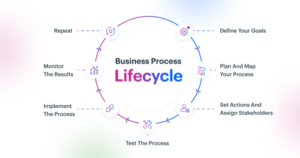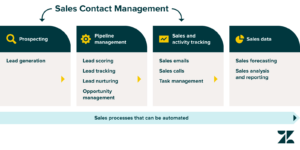The Ultimate Sales Automation Checklist for Busy Sales Professionals offers a concise guide to maximize sales productivity and efficiency. In today’s fast-paced business environment, sales professionals often face challenges in managing their time effectively.
This checklist provides practical tips and strategies to implement sales automation effectively, enabling salespeople to focus on building and nurturing customer relationships while automating repetitive tasks. By utilizing automation tools, streamlining processes, and optimizing communication channels, sales professionals can streamline their workflows, improve their productivity, and ultimately drive more sales.
Whether you’re a seasoned sales pro or just starting your sales career, this checklist is a valuable resource to help you harness the power of automation and achieve your sales goals.

Credit: blog.close.com
Step 1: Define Your Sales Processes
Step 1 in the Ultimate Sales Automation Checklist is defining your sales processes. This crucial step sets the foundation for streamlining and automating your sales tasks, ensuring maximum efficiency for busy sales professionals.
Defining your sales processes is a crucial first step in implementing sales automation for busy sales professionals. By clearly outlining the stages and workflows involved in your sales cycle, you can identify automation opportunities that will save you time and effort.
Identify Key Stages In Your Sales Process
Start by identifying the key stages in your sales process. These are the milestones that potential customers go through, from the initial lead generation to closing the sale. By understanding these stages, you can design automation strategies that streamline your interactions with leads and prospects.
Here are some common stages to consider:
- Lead Generation
- Lead Qualification
- Product Demonstration
- Negotiation
- Closing the Sale
- Follow-up and Customer Retention
Map Out Your Workflows
Once you have identified your sales stages, it’s time to map out your workflows. This entails breaking down each stage into specific actions and tasks that need to be completed. By visualizing your workflows, you can identify potential bottlenecks and areas where automation can be implemented.
| Stage | Actions and Tasks |
|---|---|
| Lead Generation | – Online advertising campaigns – Content marketing – Cold calling – Networking events |
| Lead Qualification | – Initial lead qualification – Qualifying questions – Lead scoring |
| Product Demonstration | – Scheduling demos – Presenting product features – Addressing customer concerns |
Determine Automation Opportunities
Now that you have mapped out your workflows, it’s time to determine automation opportunities. Look for tasks and actions that can be automated to reduce manual effort and increase efficiency. These can include sending automated follow-up emails, scheduling meetings, updating CRM records, or generating reports.
- Automated email follow-ups after lead generation
- Automated meeting scheduling based on availability
- Automatic CRM updates when a sale is closed
By defining your sales processes, identifying key stages, mapping out workflows, and determining automation opportunities, you can streamline your sales operations and free up time for more strategic tasks. Implementing sales automation will enable you to focus on building relationships with your customers and closing deals, ultimately boosting your productivity and sales performance.

Credit: blog.hubspot.com
Step 2: Choose The Right Sales Automation Software
Optimizing your sales process through automation is essential for busy sales professionals. In step 2, it is crucial to select the right sales automation software to enhance your productivity and streamline your sales activities.
Once you have evaluated your needs and identified the areas where you can benefit from sales automation, it’s time to choose the right sales automation software for your business. This step requires careful consideration and research to ensure that you find a tool that aligns with your needs and helps streamline your sales processes. Here are three key factors to keep in mind:
Evaluate Your Needs
Before diving into the vast array of sales automation tools available, take a moment to evaluate your specific needs. Identify the pain points and bottlenecks in your current sales processes and the areas where automation can make a significant impact. Are you struggling with lead generation? Is managing customer data becoming overwhelming? Do you need assistance with email marketing or tracking sales performance? By understanding your requirements, you can select a sales automation tool that addresses your unique challenges.
Research Available Tools
With a clear understanding of your needs, it’s time to research the available sales automation tools. Explore different options, read user reviews, and compare features and pricing. Look for tools that align with your business size, industry, and specific requirements. Moreover, consider the user-friendliness of the software, as a complex interface can lead to frustration and hinder adoption by your sales team. Take the time to find a tool that not only meets your needs but also fits seamlessly into your existing sales processes.
Consider Integration Capabilities
Integrating your sales automation software with your existing tech stack is vital for a seamless workflow. Consider the integration capabilities of the tools you are evaluating. Does the software integrate with your CRM system, email marketing platform, and other essential tools your team relies on? A lack of integration can result in manual data entry, data silos, and fragmented processes, undermining the benefits of automation. Choose a sales automation software that seamlessly integrates with your existing tools, allowing for a unified and efficient sales ecosystem.
Step 3: Set Up Automated Lead Generation
Automate your lead generation process effortlessly with step 3 of the Ultimate Sales Automation Checklist for busy sales professionals. Streamline your sales funnel and save valuable time with automated lead generation techniques.
Now that you have streamlined your sales process and have a solid foundation in place, it’s time to focus on automating your lead generation efforts. By implementing automated lead generation strategies, you can save time and ensure a steady flow of potential customers. Here are three effective ways to set up automated lead generation:
Implement Lead Capture Forms
One of the simplest yet most effective ways to generate leads automatically is by implementing lead capture forms on your website. These forms allow visitors to provide their contact information in exchange for valuable content or resources. Place these forms strategically on your website’s landing pages and blog posts to capture leads at the moment of interest.
This simple addition to your website can significantly boost your lead generation efforts. Keep the form short and straightforward, asking for only essential information such as name and email address. Make it visually appealing and use a compelling call-to-action to entice visitors to fill it out.
Leverage Social Media Automation
Social media platforms are not just for connecting with people; they can also be powerful tools for generating leads. By utilizing social media automation, you can streamline your social media presence and consistently engage with your target audience.
Start by scheduling regular posts to be published on your social media accounts, ensuring consistent visibility and engagement. Use relevant hashtags and compelling visuals to attract users and drive them to your website. Additionally, automate your social media listening, allowing you to monitor mentions, hashtags, and keywords related to your industry, thereby identifying potential leads.
Utilize Email Marketing Tools
Email marketing remains a tried-and-true method for lead generation. By utilizing email marketing tools, you can automate various aspects of your email campaigns, saving you time while maintaining a personalized approach.
Start by segmenting your email list based on customer characteristics or behavior. This allows you to send targeted and relevant emails to specific segments, increasing your chances of conversion. Next, create automated email workflows that trigger based on specific actions or events, such as when a lead signs up for a newsletter or downloads a gated piece of content.
Utilizing email marketing tools goes beyond automation; it also provides valuable insights into your email campaigns’ performance. Monitor open rates, click-through rates, and conversions to evaluate your strategies’ effectiveness and make data-driven improvements.
Setting up automated lead generation is an essential step for busy sales professionals. By implementing lead capture forms, leveraging social media automation, and utilizing email marketing tools, you can save time and generate a consistent stream of potential customers, enabling you to focus on what you do best – closing deals.
Step 4: Streamline Your Sales Communication
Streamlining sales communication is an essential step for busy sales professionals. By automating the process, you can save time and improve efficiency in your sales workflow. Discover how to do this and more with our comprehensive sales automation checklist.
In today’s fast-paced sales environment, effective communication can make all the difference. Streamlining your sales communication processes can help you save time, enhance productivity, and better engage with your leads and customers. Here are three strategies to consider:
Automate Email Follow-ups
Automating your email follow-ups can help you stay in touch with prospects and customers without the need for constant manual effort. By utilizing email automation tools, you can set up personalized and timely email sequences that are triggered based on specific actions or time intervals. This ensures that every lead receives the right message at the right time, increasing your chances of converting them into paying customers.
Utilize Sales Call Recording
Recording your sales calls can be an invaluable asset for both training purposes and enhancing customer relationships. By reviewing these recordings, you can identify areas for improvement, learn from successful interactions, and ensure consistency in your sales process. Additionally, having a record of conversations allows you to reference important details during follow-up calls, demonstrating professionalism and enhancing the customer experience.
Implement Chatbots For Instant Responses
In today’s era of instant gratification, customers expect quick responses to their inquiries. Implementing chatbots on your website or social media platforms can help you provide instant responses, 24/7. These AI-powered assistants can answer common questions, provide information about your products or services, and even collect lead information for further follow-up. By leveraging chatbots, you can ensure that no lead goes unanswered, even when your sales team is busy with other tasks. By streamlining your sales communication through automated email follow-ups, sales call recording, and chatbots, you can significantly improve your sales process and effectively engage with your leads and customers. These strategies not only save time but also enhance productivity and customer satisfaction. Implement them today to take your sales efforts to the next level.
Step 5: Optimize Your Sales Funnel
In order to maximize your sales efficiency, it is crucial to continuously optimize your sales funnel. This ensures that leads are moving smoothly through each stage of the buying journey, increasing your chances of closing deals. Here are three key strategies to optimize your sales funnel:
Implement Lead Scoring
Lead scoring is a system that allows you to rank your leads based on their level of engagement and potential to convert. By assigning scores to various actions or demographic traits of your leads, you can prioritize your efforts and focus on the most promising opportunities first. This helps you streamline your sales process and allocate your time and resources effectively. Utilize a lead scoring model that aligns with your business objectives and use it to identify your highest-quality prospects.
Automate Task Reminders
In the fast-paced world of sales, it’s easy to let important tasks slip through the cracks. By automating task reminders, you can ensure that nothing falls by the wayside. Set up notifications and alerts in your CRM system to remind you of upcoming deadlines, follow-ups, or important milestones in the sales process. This helps you stay organized and on top of your sales activities, maximizing your productivity and preventing missed opportunities.
Utilize Crm Integrations
A Customer Relationship Management (CRM) system is an essential tool for managing and tracking your sales pipeline. To optimize your sales funnel, make sure your CRM is seamlessly integrated with other tools and platforms you use, such as email marketing software, analytics tools, or project management systems. This integration allows for a seamless flow of data and information across platforms, providing you with a comprehensive view of your prospects and customers. It also streamlines your workflow, eliminating the need for manual data entry or duplication of efforts.

Credit: www.nutshell.com
Frequently Asked Questions Of The Ultimate Sales Automation Checklist For Busy Sales Professionals
What Are Some Sales Automation Tools?
Sales automation tools include CRM systems, email automation software, lead generation tools, and sales analytics platforms. These tools help streamline the sales process, automate repetitive tasks, and improve sales efficiency and effectiveness.
What Are Sales Automation Practices?
Sales automation practices refer to the use of technology and tools to streamline and automate various aspects of the sales process. This includes tasks like lead generation, follow-ups, and customer relationship management. Implementing sales automation practices can increase efficiency, improve productivity, and enhance customer engagement.
How Sales Automation Can Help Your Business Close More Deals?
Sales automation helps businesses close more deals by streamlining and optimizing the sales process. It automates repetitive tasks, tracks leads and customer interactions, and provides valuable analytics. This not only saves time but also enables sales teams to focus on building relationships and closing deals, leading to increased efficiency and higher conversion rates.
How Do You Automate A Process?
To automate a process, follow these steps: 1. Identify the manual tasks that can be done by a computer or software. 2. Find an automation tool that suits the process. 3. Install and configure the tool according to your needs. 4.
Test the automation to ensure it works as intended. 5. Monitor and maintain the automated process to identify and fix any issues.
Conclusion
Maximizing sales efficiency is key for busy sales professionals. By implementing the strategies outlined in this ultimate sales automation checklist, you can streamline your processes, save time, and boost your productivity. From prospecting to follow-ups, automating various tasks can free up valuable time to focus on building relationships and closing deals.
Embrace the power of automation and take your sales game to the next level. Get started today and witness the transformation in your sales process.




